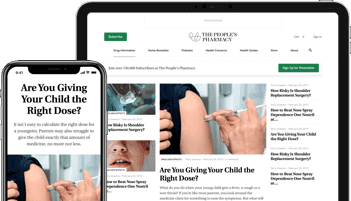
One of the most remarkable things on television these days is drug advertisements. These commercials usually include long lists of potentially very dangerous side effects, yet the public largely remains enthusiastic about pharmaceuticals. Only the USA and New Zealand allow direct-to-consumer advertisements for prescription drugs.
No other products advertised on TV are accompanied by so many warnings. Those for prescription drugs are far lengthier than those that once accompanied cigarettes when cigarettes were advertised on TV.
Why Don’t Warnings Discourage Drug Use?
Normally, when someone is confronted with scary warnings about a wide range of hazards we encounter in life, the tendency is to shy away from whatever is the subject of that warning. But the opposite seems to occur with drug advertisements on television. These advertisements somehow increase the demand for pharmaceuticals. Although many drugs are essential and some are even life saving, many others do not come anywhere close to fitting that description.
Why does the public seem to ignore the long lists of potentially serious side effects listed in drug advertisements on TV? Our brain is telling us to be cautious, while TV drug advertisements encourage mindless consumption. Pharma marketing promotes hedonistic consumption that is no different from the marketing of any other consumer product.
Do Long Lists of Side Effects Numb Your Brain?
In my opinion, the psychological effect of hearing long lists of scary side effects in drug advertisements should be to prompt people to do everything in their power to prevent the medical condition targeted by the drug so that people can avoid needing to take that drug.
As a result of one of my commentaries in Drug Topics lamenting the lack of emphasis on prevention in our health care system, one pharmacist sent me an e-mail in which he said that he became a vegetarian in an effort to avoid having to take the drugs that he dispenses all day long.
Other people don’t seem to have that reaction. As a pharmacist, I have heard many people say things like, “Yeah. The side effect occurs in one person in a million so the government (FDA) requires the drug company to list every possible side effect.”
What Does FDA Approval Mean?
FDA approval doesn’t really mean a drug is safe. Perhaps it only means that the drug company has met the narrow legal standard for disclosure. In the real world, the FDA expects physicians to weigh the risks versus benefits of drugs. The FDA in effect passes the buck to physicians. But busy physicians assume that if the FDA approves a drug, then it must be safe.
Drug Advertisements Divert Attention from the Importance of Prevention:
One of the most unfortunate effects of the ubiquity of drug advertisements on television is that people conclude that pharmaceuticals are the only reasonable way to address a wide range of ailments and medical problems. In my opinion, drug advertisements should include a substantial section on what is currently known about dietary/nutritional, lifestyle, psychological, and environmental factors in the causation and prevention of that condition.
Most of the prescriptions that pharmacists fill are for what’s known as diseases of modern civilization or diseases of affluence. This includes elevated blood pressure, elevated cholesterol, elevated blood sugar in type 2 diabetes, gout, osteoporosis, asthma, coronary heart disease, cerebrovascular disease, peripheral vascular disease, obesity, cancer, alcoholism, and some types of allergy.
Worldwide Incidence Data:
In addition to prominently listing potential drug side effects, the advertisements should include a substantial section on what is known about the prevention of that condition. They should mention the fact that the incidence of the condition may vary significantly around the world. Moreover, they should discuss the reasons for that variation in incidence when they are known.
Take breast cancer for example.It is a significant source of illness and even mortality in the US.
According to the World Health Organization,
“Incidence rates [for breast cancer] vary greatly worldwide from 19.3 per 100,000 women in Eastern Africa to 89.7 per 100,000 women in Western Europe.”
Wouldn’t it be enlightening if advertisements for drugs that treat breast cancer were required to include such worldwide incidence data? This might prompt the public to demand that priority be given to cancer prevention rather than chemotherapy.
What Does “Safe and Effective” Really Mean?
The FDA declares that the drugs it approves are safe and effective, but many of the potential side effects listed in drug advertisements certainly do not coincide with the layman’s definition of safe. Death is often mentioned as a possible adverse effect of many of the drugs heavily advertised on television. The reality is that FDA approval does NOT mean that a drug is safe by the layman’s understanding of that word.
Cognitive Dissonance:
In psychology, cognitive dissonance is the mental stress or discomfort experienced by an individual who holds two or more contradictory beliefs at the same time. According to Wikipedia, cognitive dissonance theory is founded on the assumption that individuals seek consistency between their expectations and their reality. An individual who experiences inconsistency (dissonance) tends to become psychologically uncomfortable. Since it is impossible for a thinking person to hold two mutually exclusive beliefs simultaneously, they often become anxious.
Cognitive dissonance is inevitable in every pharmacist’s life when faced with these contradictions:
- The contradictions between the glowing picture of drugs painted by direct-to-consumer advertising and the reality of a long list of potential side effects
- The contradiction between the FDA’s seal of approval and the reality that many side effects don’t even appear until after a drug is on the market
- The contradiction between the fact that our health care system is based on drugs and the reality that prevention is safer and more effective than pills
Cognitive dissonance often arises when there is conflict between a pharmacist’s positive concept of himself/herself and the reality. For example, a pharmacist might believe: “The drugs that I dispense are safe and effective.” As a result, this person might fail to recognize that some drugs do more harm than good.

How Do Pharmacists Handle this Disconnect?
Do we react with hostility and denial toward customers who sometimes question the safety of the drugs we dispense? Or do we confront the reality that FDA approval does not mean a drug is safe? On the one hand, our instincts tell us that human health is primarily the result of basic factors such as eating properly, maintaining a healthy weight, embracing an active lifestyle, avoiding the use of tobacco and alcohol, etc. On the other hand, our health care system is based on the manipulation of molecules and cells with powerful synthetic chemicals called pharmaceuticals. How does one reconcile these opposing views of human health?
Mechanistic vs. Holistic:
- Why does our health care system have a mechanistic and reductionist focus on molecules and cells, rather than a holistic focus on nutrition and lifestyles?
- Why is modern medicine fixated on alpha blockers, beta blockers, calcium channel blockers, H2 antagonists, proton pump inhibitors, HMGCoA reductase inhibitors, etc.?
- Has modern medicine miraculously discovered errors in tens of thousands of years’ worth of human evolution?
- Why is modern medicine obsessed with attacking and overwhelming delicate biological processes with synthetic chemicals foreign to human evolution?
- Why is our health care system fixated on chemistry rather than on nutrition and lifestyles?
- Why are pharmacists in the business of pushing pills rather than changing lifestyles?
This question is especially relevant in light of the fact that major dietary and lifestyle changes can, in general, do more than medication to improve health. In order to lessen the inner turmoil caused by the attempt to hold diametrically opposed views simultaneously, pharmacists have to adapt to big contradictions. How do pharmacists reconcile Pharma’s rosy view of drugs with the reality of long lists of potentially serious adverse effects?


